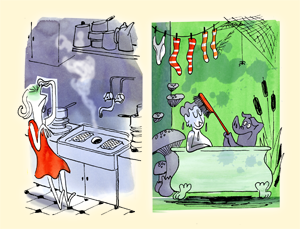A dirty kitchen or a dirty bathroom?

Yes, dirty bathrooms and dirty kitchens both offer problems. But as a public health official who has inspected a lot of kitchens over the years, I would have to say that you're better off drinking out of the toilet (well, a clean toilet) than eating off the average nasty cutting board. And this applies to private homes no less than commercial establishments.
The cutting board, with its hard-to-clean cracks—perfect for bacteria—is just one of the problem areas in the kitchen. There's the germ-ridden sponge on your sink: extremely difficult to clean. (Some experts suggest a thorough wash and rinse, followed by some nuking in the microwave; others recommend disinfecting the sponge with bleach and leaving it out to dry.) And there's the kitchen hand towel, which can pick up germs when you dry dishes, or your hands, and then contaminate the next set of dishes you dry. (Solution: change the towel often, even after every use.)
Not to mention dried food particles on the refrigerator or in the microwave. These surfaces can become infested and should be wiped clean as often as possible. Consider, as well, the very real dangers of leaving food out or storing it at improper temperatures.
This is not to say that bathrooms are inherently germ-free. Mold and fungus can grow in the shower or under the bathtub mat. (Clean daily with a Clorox sanitizer.) A sink full of shaving water can harbor microbes. And don't forget to clean off and air-dry your toothbrush.
But you don't hear about too many cases of bathroom poisoning. In the bathroom, if you wash your hands, you're generally okay. The kitchen presents a good deal more uncertainty.
—Dennis G. Murray '79. Murray is the former health commissioner for Knox County, Ohio. He earned a master's degree from the University of Michigan School of Public Health and has performed more than thirty years of public health work in Ohio and Michigan.

 Delicious
Delicious Facebook
Facebook StumbleUpon
StumbleUpon Digg
Digg reddit
reddit